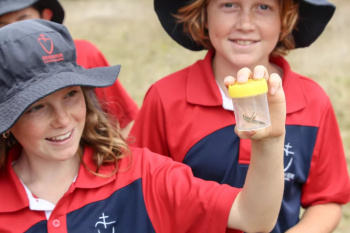
South Australian Science Teachers Association
Regional school students buzzing over citizen science project results
Posted by SASTA
on 09/12/2022

Budding junior entomologists from 50 regional schools in South Australia, Queensland and Western Australia have successfully recorded thousands of new insects as part of the South Australian Museum’s citizen science project, Insect Investigators.
The project which launched in September 2021 connected regional and remote school students with researchers to learn about Australia’s rich biodiversity.
Each school set-up an insect trap in March 2022 which they used to collect and monitor local insects over a four-week period. From this, more than 14,000 insect specimens were selected to be DNA barcoded by the Centre for Biodiversity Genomics at The University of Guelph in Canada, and today the DNA barcoding results will be released.
Only around 30 percent of the estimated 225,000 insect species in Australia are formally named and described. DNA barcoding involves sequencing a small section of the genome and using the variation among these barcodes to discriminate species, explains project leader Dr Erinn Fagan-Jeffries.
“While the gold standard is always going to be identifying and describing insects using DNA data in combination with their physical characteristics, the DNA barcodes provide a fast and cost-effective way of shining a light on the remarkable diversity of insects in Australia that we know so little about,” she said.
Through Insect Investigators, participating schools have added more than 12,500 new DNA barcodes to the international online repository, the Barcode of Life Database. The variation among these barcodes suggests that there are more than 5,000 different species present among the specimens, and just over 3,000 of those are brand new records on the database.
Each of these DNA barcodes relates back to an individual insect specimen that will be deposited in the entomology collections at the South Australian Museum, Queensland Museum and the Western Australian Museum. Taxonomists from around Australia will then be able to examine and determine if they represent undescribed species.
“It is highly likely that all contributing schools have found species new to science which is really exciting, but how many of these species we are actually able to describe is dependent on the resources and support available for taxonomy,” shared Dr Fagan-Jeffries.
“Despite there currently being many more insect groups than taxonomists, we are hopeful that the taxonomists will be able to spot some new species that can be described, and in those cases, the students will then be invited to name the unique species that they have discovered,” she said.
The DNA barcoding results will be publicly released today on the Insect Investigators website: https://insectinvestigators.com.au.
Insect Investigators received grant funding from the Australian Government, is led by the South Australian Museum, and involves 17 partner organisations.
Participating schools in South Australia:
- Ceduna Area School
- Crystal Brook Primary School
- Elliston Area School
- Encounter Lutheran College Victor Harbor
- Faith Lutheran College Tanunda
- Kangaroo Island Community Education
- Kingston Community School
- Koonibba Aboriginal School
- Loxton North School
- Mimili Anangu School
- Rendelsham Primary
- Roxby Downs Area School
- Sandy Creek Primary
- Streaky Bay Area School
- Trinity College Gawler
- Wallaroo Mines Primary School
- Yalata Anangu School
Archive
- December 2025
- November 2025
- October 2025
- September 2025
- August 2025
- July 2025
- June 2025
- May 2025
- April 2025
- March 2025
- February 2025
- January 2025
- December 2024
- November 2024
- October 2024
- September 2024
- August 2024
- July 2024
- June 2024
- May 2024
- April 2024
- March 2024
- February 2024
- December 2023
- November 2023
- October 2023
- September 2023
- July 2023
- June 2023
- May 2023
- April 2023
- March 2023
- February 2023
- January 2023
- December 2022
- November 2022
- October 2022
- August 2022
- July 2022
- June 2022
- May 2022
- April 2022
- March 2022
- February 2022
- January 2022
- December 2021
- November 2021
- October 2021
- September 2021
- August 2021
- July 2021
- June 2021
- May 2021
- April 2021
- March 2021
- February 2021
- January 2021
- December 2020
- November 2020
- October 2020
- September 2020
- August 2020
- July 2020
- June 2020
- May 2020
- April 2020
- October 2018
- September 2018
- August 2018
- July 2018
